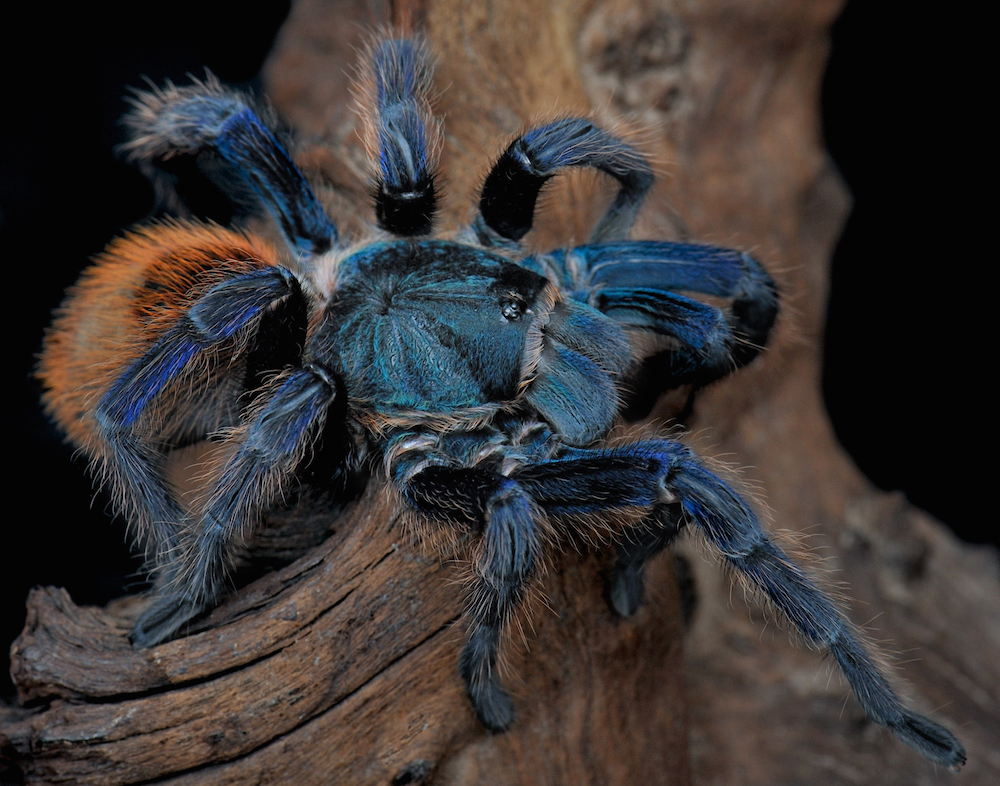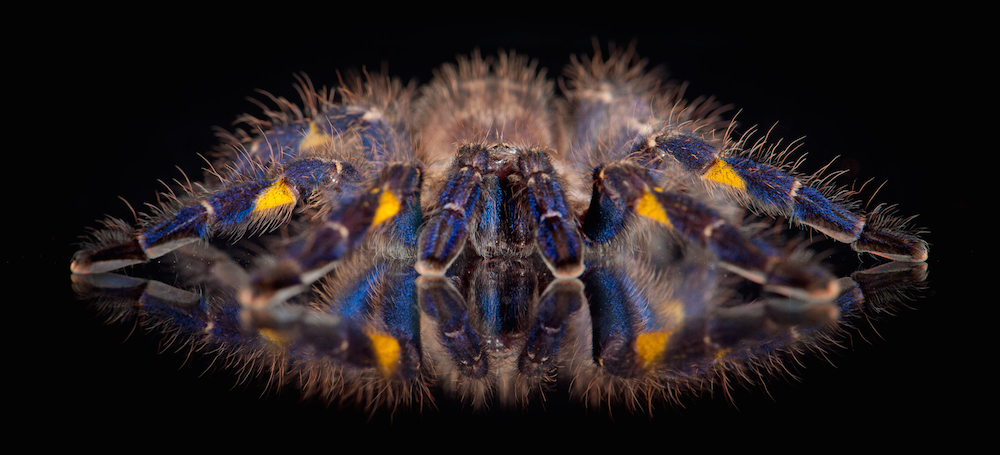Why So Blue? Tarantula's Cool Color Is Still a Mystery

It's eight-legged, furry and a very cool shade of cobalt blue. What is it? A tarantula, of course!
While tarantulas aren't normally associated with the color blue, many of these critters have a distinct cobalt hue, which is produced by tiny structures located on the animals' hairy bodies and appendages. Known as photonic nanostructures, the itsy-bitsy structures reflect blue light, turning a creepy-crawly arachnid into something resembling an eight-legged Cookie Monster.
Scientists have known about the tarantula'slight-scattering hairs for some time, but a recent study took a closer look at the nanostructures that make so many spiders in the family Theraphosidae appear blue. The study found that the blue-reflecting nanostructures are unlikely to have evolved as a result of sexual selection, which is often responsible for the bright colors that distinguish closely related species. (The vividly colored peacock spiders provide an excellent example.) [Goliath Birdeater: Images of a Colossal Spider]
Tarantulas, on the other hand, are largely nocturnal and they don't appear to use their coloration for mating purposes, the researchers found. Instead, the scientists hypothesized that the tarantula's blue hue may be a result of natural selection. In other words, being blue helps certain tarantula species survive in their environments.
To back up this hypothesis, the new study notes the presence of blue-reflecting nanostructures across many species of tarantulas that are not closely related. And these nanostructures are quite distinct from one another (i.e., they don't look the same under a microscope) in various genera of tarantula, a finding that suggests the structures developed independently many times over the course of the tarantula's long evolution, said study lead author Bill Hsiung, a postgraduate student in biology at the University of Akron in Ohio.
Why so blue?
To learn more about the tarantula's coloring, Hsiung and his colleagues first looked at digital images of the critters to create a phylogenetic tree— a chart that shows the evolutionary relationships between related species. They charted the evolutionary history of tarantulas from 53 genera (the family Theraphosidae contains more than 100 genera in total) and found that at least 40 of these genera had almost the exact same blue coloration. By contrast, only 12 genera of tarantulas were found to have green coloring.
Get the world’s most fascinating discoveries delivered straight to your inbox.
"These blues are so specific. They're pretty much the same hue. I think this wavelength was selected specifically for communicating with potential predators or prey — though we don't know that," Hsiung told Live Science. Ecological studies of tarantula behavior will need to be conducted to confirm that hypothesis, he added.
But why blue, specifically? If a tarantula can use its nanostructures to appear blue, then presumably it could also use similar nanostructures to appear to be a different color — like yellow or green, the scientists said. Yet green, in particular, is not this critter's color of choice. Blue-reflecting nanostructures, on the other hand, evolved independently at least eight times in different species, the researchers found.
This preference for blue could be a result of the tarantula's typical habitat. They often live on the floor of rainforests and other heavily vegetated areas, where the light spectra consist mostly of green colors, Hsiung said.
"If they were green, and the predators and prey in their environments evolved to see green and are very sensitive to the green spectrum, then the [tarantulas] would appear very bright," Hsiung said. "And being too bright in an environment is not a good thing. Maybe blue is a good trade-off — different enough from the background to be seen, but not too bright."
Structural differences
After sorting dozens of tarantula images, Hsiung and his colleagues decided to get their hands on a few live specimens. The researchers obtained eight blue tarantulas that are indigenous to distinct geographic locations, including Singapore, India, Chile and Brazil. They examined the creatures' light-scattering photonic nanostructures, or "structure colors," using high-powered microscopes. What they found surprised them. [Photos: The World's Creepiest Spiders]
"We discovered not just one kind of nanostructure but at least two or three different kinds of nanostructures that produce the same blue colors," Hsiung said. "Previously only one kind of nanostructure had been recorded as producing blue color in tarantulas, but we found that there are other types."
Structure colors like those of the blue-hued tarantulas are not uncommon in nature. Many species of birds and insects also get their colors from nanostructures, rather than the pigments that color the hair and skin of many animals (like humans). However, the tarantula's structure color differs from those of birds and bugs in an important way — it isn't iridescent. That is, the spider's blue color doesn't seem to change when you look at it from different angles.
"These blues have this low iridescence to them, so they're very consistent in their appearance as you look at them from different angles. That's pretty unusual for structural colors," Todd Blackledge, a biology professor at the University of Akron and one of the co-authors of the new study, told Live Science.
The iridescence of structure colors is a problem for those who want to use these light-scattering structures in the real world, Blackledge said. Photonic nanostructures could be used to color things like electronic screens and even clothing, but only if the iridescent properties can somehow be tamed. (A tablet screen that constantly changes colors just won't cut it.)
And taming structural colors is something that Hsiung is very interested in doing. These nanostructure-produced colors offer several advantages over colors created by pigments, Hsiung said.
"Structure colors are usually brighter, and [they] won't fade over time as long as their nanostructures are still intact. These are advantages that people want to use to make color displays for phones, or pigments you can use in your cosmetics or in your clothes. Iridescence is a big constraint in those applications because we usually don't want color to change when we change our viewing angle," Hsiung said.
The tarantula's blue hues could inspire new, non-iridescent structure colors, according to Hsiung, who noted that these colors would not only be brighter and less likely to fade than pigment-based colors, they'd also be better for the environment.
"We can decrease waste and use more eco-friendly materials to produce structure colors, unlike the current dyes [used to make pigments]," Hsiung said.
To produce different structure colors, researchers just need to change the spacing between one nanostructure and the next (which changes the way the structures scatter and absorb light). Producing different pigments is a totally different process in which an entirely new material must be made for every color you want to create, Hsiung said. And sometimes, the materials used to make the pigments that color fabrics and other materials are toxic, he added.
But don't expect to buy a pair of nanostructure-colored bluejeans anytime soon. Hsiung said the structure colors of the future are still too cutting edge to be economically viable for consumers. But the tarantula study brings researchers a step closer to harnessing the power of these tiny light-reflecting formations, he said.
The tarantula study was published Nov. 27 in the journal Science Advances.
Follow Elizabeth Palermo @techEpalermo. Follow Live Science @livescience, Facebook & Google+. Original article on Live Science.
 Live Science Plus
Live Science Plus







